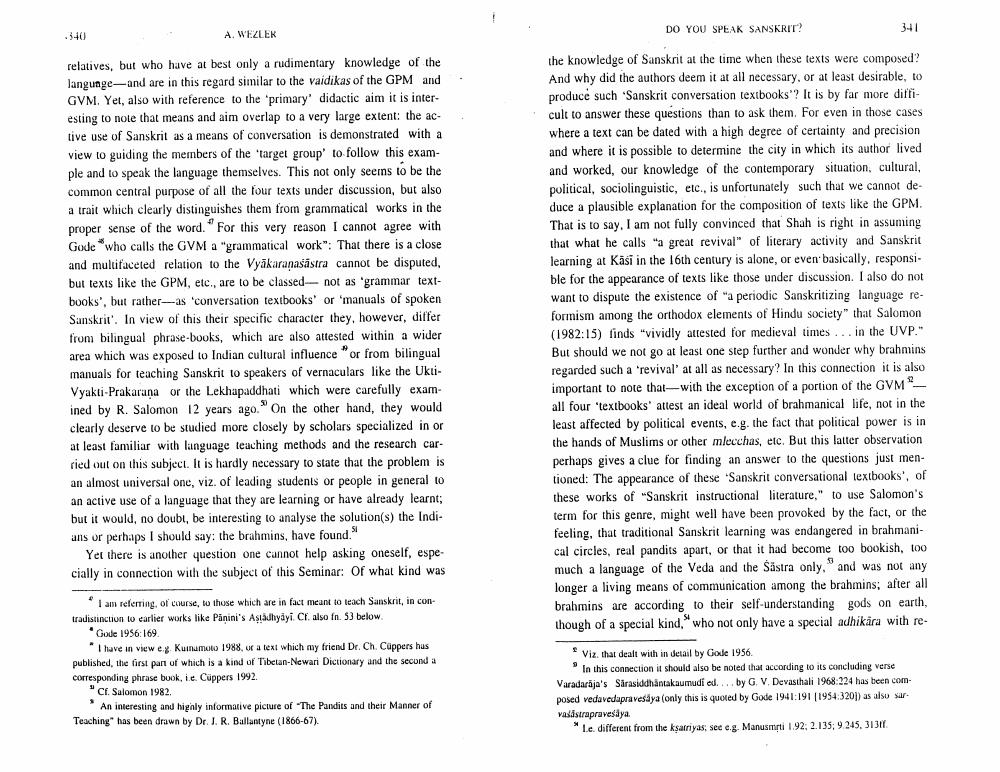________________
.340
A. WEZLER
relatives, but who have at best only a rudimentary knowledge of the langunge and are in this regard similar to the vaidikas of the GPM and GVM. Yet, also with reference to the 'primary' didactic aim it is interesting to note that means and aim overlap to a very large extent: the active use of Sanskrit as a means of conversation is demonstrated with a view to guiding the members of the 'target group' to follow this example and to speak the language themselves. This not only seems to be the common central purpose of all the four texts under discussion, but also a trait which clearly distinguishes them from grammatical works in the proper sense of the word. For this very reason I cannot agree with Gode who calls the GVM a "grammatical work": That there is a close and multifaceted relation to the Vyakaraṇasastra cannot be disputed, but texts like the GPM, etc., are to be classed not as 'grammar textbooks', but rather-as 'conversation textbooks' or 'manuals of spoken Sanskrit. In view of this their specific character they, however, differ from bilingual phrase-books, which are also attested within a wider area which was exposed to Indian cultural influence "or from bilingual manuals for teaching Sanskrit to speakers of vernaculars like the UktiVyakti-Prakarana or the Lekhapaddhati which were carefully examined by R. Salomon 12 years ago." On the other hand, they would clearly deserve to be studied more closely by scholars specialized in or at least familiar with language teaching methods and the research carried out on this subject. It is hardly necessary to state that the problem is an almost universal one, viz. of leading students or people in general to an active use of a language that they are learning or have already learnt; but it would, no doubt, be interesting to analyse the solution(s) the Indians or perhaps I should say: the brahmins, have found."
Yet there is another question one cannot help asking oneself, especially in connection with the subject of this Seminar: Of what kind was
I am referring, of course, to those which are in fact meant to teach Sanskrit, in contradistinction to earlier works like Panini's Astädhyayi. Cf. also fn. 53 below.
Gode 1956:169.
"I have in view e.g. Kumamoto 1988, or a text which my friend Dr. Ch. Cüppers hus published, the first part of which is a kind of Tibetan-Newari Dictionary and the second a corresponding phrase book, i.e. Cüppers 1992.
Cf. Salomon 1982.
An interesting and highly informative picture of "The Pandits and their Manner of Teaching" has been drawn by Dr. J. R. Ballantyne (1866-67).
DO YOU SPEAK SANSKRIT?
the knowledge of Sanskrit at the time when these texts were composed? And why did the authors deem it at all necessary, or at least desirable, to produce such 'Sanskrit conversation textbooks"? It is by far more difficult to answer these questions than to ask them. For even in those cases where a text can be dated with a high degree of certainty and precision and where it is possible to determine the city in which its author lived and worked, our knowledge of the contemporary situation, cultural, political, sociolinguistic, etc., is unfortunately such that we cannot deduce a plausible explanation for the composition of texts like the GPM. That is to say, I am not fully convinced that Shah is right in assuming that what he calls "a great revival" of literary activity and Sanskrit learning at Käsi in the 16th century is alone, or even basically, responsible for the appearance of texts like those under discussion. I also do not want to dispute the existence of "a periodic Sanskritizing language reformism among the orthodox elements of Hindu society" that Salomon (1982:15) finds "vividly attested for medieval times... in the UVP." But should we not go at least one step further and wonder why brahmins regarded such a 'revival' at all as necessary? In this connection it is also important to note that with the exception of a portion of the GVMall four 'textbooks' attest an ideal world of brahmanical life, not in the least affected by political events, e.g. the fact that political power is in the hands of Muslims or other mlecchas, etc. But this latter observation perhaps gives a clue for finding an answer to the questions just mentioned: The appearance of these 'Sanskrit conversational textbooks', of these works of "Sanskrit instructional literature," to use Salomon's term for this genre, might well have been provoked by the fact, or the feeling, that traditional Sanskrit learning was endangered in brahmanical circles, real pandits apart, or that it had become too bookish, too much a language of the Veda and the Săstra only," and was not any longer a living means of communication among the brahmins; after all brahmins are according to their self-understanding gods on earth, though of a special kind," who not only have a special adhikara with re
341
3
Viz. that dealt with in detail by Gode 1956.
"In this connection it should also be noted that according to its concluding verse Varadaraja's Särasiddhantakaumudi ed... by G. V. Devasthali 1968:224 has been composed vedavedapravesaya (only this is quoted by Gode 1941:191 [1954:3201) as also sarvasástrapravesaya.
"Le. different from the ksatriyas; see e.g. Manusmrti 1.92; 2.135; 9.245, 3131.




